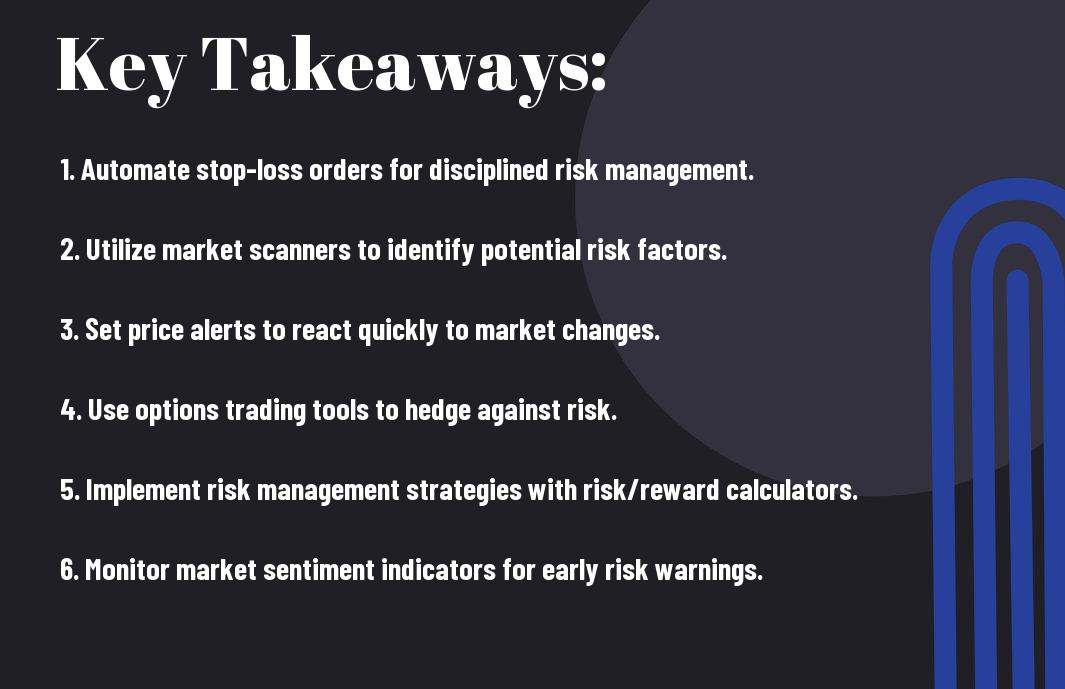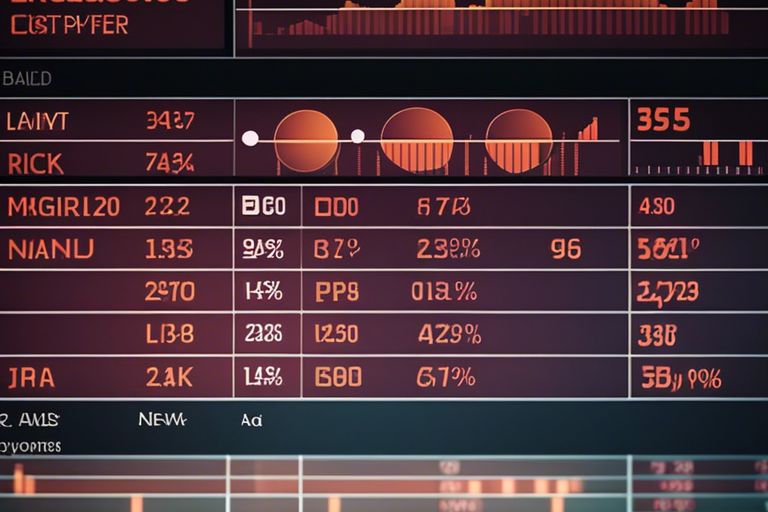Overwhelmed by the complexities of managing risks in the market? Fear not, as market trading tools are here to guide you through the turbulent waters of trading. By utilizing these tools, you can gain a better understanding of the market trends, set up stop-loss orders, and even create automated trading strategies to mitigate risks. Let’s examine into how these tools can be your trusted companions in navigating the uncertainties of trading.
Key Takeaways:
- Automated risk monitoring: Market trading tools can help traders by providing real-time risk monitoring and alerts for potential risks in their portfolio.
- Advanced analytics: These tools offer advanced analytics and risk assessment tools that can help traders to analyze their positions and make informed decisions to manage risk effectively.
- Stop-loss and limit orders: Market trading tools allow traders to set stop-loss and limit orders to automatically execute trades when certain price points are reached, helping to minimize potential losses and lock in profits.
The Importance of Risk Management
A successful trader understands the importance of risk management in the dynamic world of financial markets. By implementing effective risk management strategies, you can protect your trading capital and optimize your profit potential. Utilizing Trading Risk Management Tools & Strategies can help you navigate the uncertainties of trading and make informed decisions with confidence.
Defining Risk in Trading
The first step in managing risk effectively is to define what risk means in the context of trading. In trading, risk refers to the potential for financial loss due to market fluctuations or unforeseen events. By identifying and quantifying the risks associated with each trade, you can develop a risk management plan that aligns with your trading goals and risk tolerance.
Consequences of Poor Risk Management
With poor risk management practices, you expose yourself to a range of potential consequences that can jeopardize your trading career. Ignoring risk management can lead to significant capital erosion, emotional stress, and impulsive decision-making. Additionally, a lack of risk management discipline may result in missed trading opportunities and overall poor performance.
Avoiding proper risk management can lead to a downward spiral in your trading account. Without safeguards in place, you are vulnerable to large losses that can significantly hinder your long-term trading success. By prioritizing risk management and utilizing the right tools, you can enhance your trading performance and protect your capital from unnecessary risks.


Market Trading Tools Overview
Clearly, market trading tools play a crucial role in helping you manage and mitigate risks in your trading activities. These tools offer various functionalities that can assist you in making informed decisions and executing your trading strategies effectively.
Types of Trading Tools
- Technical Analysis Tools
- Algorithmic Trading Platforms
- Risk Management Tools
- News and Market Sentiment Analysis Tools
- Portfolio Management Software
This diverse set of tools provides you with the necessary resources to analyze market trends, automate trading processes, manage risks, stay informed about market news, and track your investment portfolio effectively. This comprehensive approach to trading tool utilization can significantly enhance your trading experience and help you achieve your financial goals.
| Trading | Benefits |
| Technical Analysis Tools | Help in identifying potential entry and exit points |
| Algorithmic Trading Platforms | Automate trading strategies and reduce human errors |
| Risk Management Tools | Monitor and control risks effectively |
| News and Market Sentiment Analysis Tools | Stay updated on market events and sentiments |
| Portfolio Management Software | Track and manage your investments efficiently |
How Trading Tools Can Assist in Risk Management
Tools designed specifically for risk management can help you assess and mitigate potential risks associated with your trading activities. These tools offer features such as stop-loss orders, risk/reward ratio calculators, and position sizing calculators to help you manage your exposure effectively.
Overview
By utilizing a combination of trading tools tailored to your needs, you can enhance your risk management strategies and make more informed decisions in the fast-paced world of trading. Take advantage of these tools to stay ahead of market fluctuations and protect your investments from unexpected downturns.
Identifying and Assessing Risk
Many market trading tools offer a variety of market analysis techniques that can help you effectively identify and assess risks in your trades.
Market Analysis Techniques
One common technique used in market analysis is technical analysis, where historical price data is used to forecast future price movements. By examining charts, graphs, and patterns, you can better understand market trends and potential risks associated with them.
Identifying Potential Risks
Analysis of potential risks involves evaluating factors that can impact the success of your trades, such as market volatility, economic indicators, and geopolitical events. By staying informed and utilizing market trading tools that provide real-time data and analysis, you can proactively identify and address potential risks before they escalate.
It is vital to conduct a thorough analysis of potential risks before entering any trade to develop a risk management strategy that aligns with your investment goals and risk tolerance. By utilizing market trading tools effectively, you can enhance your decision-making process and mitigate potential risks in your trading activities.
Setting Stop-Losses and Limit Orders
Keep How AI can be an effective tool in Risk Management handy when utilizing market trading tools for risk management. One important aspect of risk management in trading is setting stop-losses and limit orders. These tools help you minimize potential losses and protect your investment capital in the volatile world of trading.
The Role of Stop-Losses in Risk Management
Orders play a crucial role in managing risk as they allow you to set a specific price at which your trade will automatically close, limiting your losses if the market moves against you. By implementing stop-loss orders, you can control risk by defining the maximum amount you are willing to lose on a trade, thus protecting your capital and preventing emotional trading decisions in the heat of the moment.
How to Set Effective Stop-Losses
Any successful trader knows the importance of setting effective stop-loss orders. When determining where to place your stop-loss, consider technical analysis, support and resistance levels, market volatility, and your risk tolerance. Avoid setting stop-loss orders too close to the entry price, as this may result in premature exits due to market fluctuations. It’s crucial to strike a balance between minimizing potential losses and giving your trade enough room to breathe.
Another key aspect to consider when setting stop-losses is to reassess and adjust them as the trade progresses. Market conditions can change quickly, so periodically reviewing and modifying your stop-loss levels can help you adapt to evolving market dynamics and protect your gains.
Using Limit Orders to Manage Risk
With limit orders, you have the power to set a specific price at which you want to buy or sell an asset. This tool can assist you in managing risk by allowing you to enter or exit trades at predetermined price levels, helping you avoid unexpected price fluctuations that can lead to losses. By using limit orders effectively, you can maintain discipline in your trading approach and avoid impulsive decisions that may result in unnecessary risk exposure.
Manage your risk effectively by incorporating limit orders into your trading strategy. These orders provide you with more control over the execution price of your trades, allowing you to navigate the market with a structured plan and reduce the impact of sudden price movements on your investment portfolio.

Position Sizing and Diversification
The Impact of Position Sizing on Risk
After identifying your trading strategy and setting your risk tolerance, the next crucial step in risk management is determining the appropriate position size for each trade. Position sizing refers to the number of shares or contracts you take on a trade in relation to your overall capital. By carefully considering your position size, you can control the amount of risk you take on each trade. For example, if you have a high-risk tolerance, you may choose to take larger positions, but if you are more risk-averse, smaller positions may be more suitable.
Diversification Strategies for Risk Reduction
Any experienced trader will tell you that one of the most effective ways to manage risk in the market is through diversification. Diversification involves spreading your investments across different assets, industries, or even geographic regions. By diversifying your portfolio, you can reduce the impact that any single investment or market event may have on your overall wealth. This strategy can help you avoid significant losses if a particular sector experiences a downturn or a specific asset underperforms.
Risk can never be entirely eliminated from trading, but by implementing proper position sizing and diversification strategies, you can effectively manage and mitigate potential risks in the market. Be mindful of, the key to successful trading is not only in making profitable trades but also in protecting your capital from significant losses.
Monitoring and Adjusting
Real-Time Market Monitoring
All successful traders understand the importance of real-time market monitoring. By utilizing market trading tools that offer real-time data and analysis, you can stay informed and make quick decisions to manage and reduce risk. These tools provide you with up-to-the-second information on market trends, price movements, and news that may impact your trades. By staying vigilant and alert to market changes, you can adjust your strategies promptly to mitigate potential risks.
Adjusting Trading Strategies Based on Risk
Monitoring your trading strategies based on risk is crucial for long-term success in the market. Market trading tools can help you track your risk exposure and performance metrics. By analyzing the data provided by these tools, you can identify areas of weakness in your strategies and make necessary adjustments to minimize risk. Whether it’s revising your stop-loss levels, diversifying your portfolio, or scaling back on high-risk trades, these tools empower you to adapt your trading approach to the ever-changing market conditions.
Risk: It’s imperative to understand that risk is inherent in trading, but with the right tools and strategies, you can effectively manage and mitigate it. By continuously monitoring your risk exposure and adjusting your trading strategies accordingly, you can enhance your chances of success and protect your investments in the unpredictable world of market trading.
To wrap up
So, by utilizing market trading tools, you can effectively manage risks associated with your investment portfolio. These tools provide you with real-time data, analysis, and insights that help you make informed decisions, reduce potential losses, and maximize profits. Whether you are a seasoned investor or just starting out, incorporating trading tools into your strategy can be a game-changer in navigating the complex world of financial markets.
FAQ
Q: How do market trading tools assist in risk management?
A: Market trading tools help in risk management by providing traders with real-time data and analytics that enable them to make informed decisions. These tools can help identify potential risks, set up stop-loss orders, and monitor market trends to mitigate risks effectively.
Q: What are some common features of market trading tools that support risk management?
A: Common features of market trading tools that support risk management include risk assessment tools, volatility indicators, automated trading options, backtesting capabilities, and customizable alerts for price movements. These features help traders proactively manage and minimize risks in their trading strategies.
Q: How can market trading tools help in diversifying and hedging against risks?
A: Market trading tools provide traders with access to a wide range of financial instruments, such as stocks, options, futures, and forex, allowing them to diversify their portfolios. Additionally, these tools offer hedging strategies, such as options contracts and futures contracts, which can help offset potential losses in one asset class with gains in another, thus reducing overall risk exposure.



